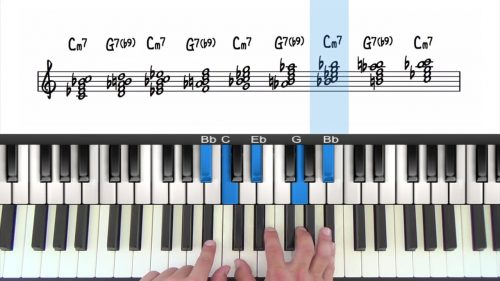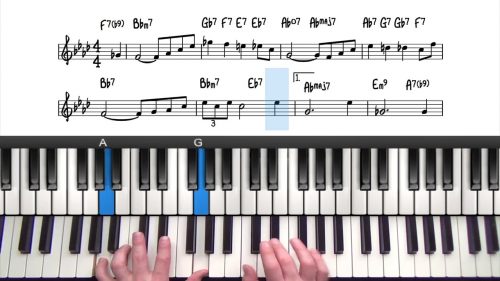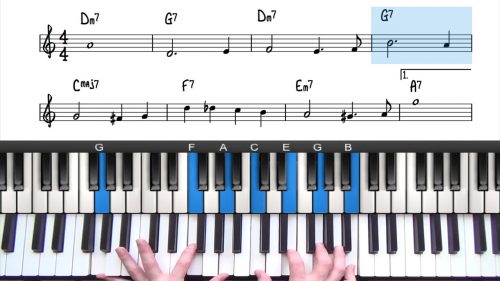Harmonising Step-Wise Melody Lines
Welcome to this 5 minute masterclass on harmonising step-wise melody lines. We are going to take the well-know tune “In A Sentimental Mood” and look at the different options we have available to harmonise the ascending melodic motif at the start of each A Section.
We will explore the 4-way-close, drop 2 voicings, passing chords, and finally reharmonising the melody with quartal voicings.
Why would we want to use this you might ask?
Well these techniques are optional things you can do to enhance, tweak, or even completely change the sound of the melody.
The reason I’ve chosen this tune is that the same ascending melodic figure repeats 3 times in the head of the tune and understanding these concepts will allow you to add a variety of colours, textures, and expression to an otherwise identical melody line.
The 4-Way-Close & Drop 2 Voicings
The 4-way close is a method to harmonise a step wise melody line with alternating 7th chords and rootless dominant b9 chords. For each chord tone we simply play the root position 7th chord with the top of bottom note doubled.
For none chord tones, we simply build a diminished chord with the top and bottom note doubled.
We can then create a more open sounding voicing by dropping the second note into our left hand.
Add Passing Chords
We can introduce a passing chord for the last note of the ascending line to create a stronger sense of resolution into the next bar. We can use the normal V7 chord, or alternatively, the tritone substitution.
Reharmonisation
A more complex option is to rehamonise the whole passage. I like to do this So What Chords. The So What Chord is a quartal voicing which are harmonically ambigious – making them well-suited to rehamonise melodies.
It’s now over to you to apply these concepts to the tunes you are playing. If you do have any
questions with the material I have covered, just drop it in the comment box below.
Lesson Downloads
-
Harmonising Melodies Lesson Notation File Type: pdf
Practice Tips
-
Harmonise any step wise melody line by alternating 7th chords and rootless dominant b9 chords. This is known as the "4-way-close".
-
Take this a step further by dropping the second to top notes into your left hand. This is known as "Drop 2 Voicings"
-
Drop 2 voicings have a more modern & sophisticated sound. We now have a different interval structure in between the notes of the voicing.
-
Experiment with passing chords to create a stronger sense of resolution into the next bar.
-
A final option is to reharmonise the whole passage. So What chords are particularly useful for this as demonstrated in the lesson.
-
You can find a dedicated jazz standard lesson on this tune, and also check out the related lessons above for more information on the 4-way close and drop 2 voicings.








excellent as always. I love So What chords too :)
Hey Hayden,
Question about which chord to base the voicings on. In ‘In a Sentimental Mood’, for the 4 way close, are we using D, F, A, C because the melody line is leading up to a D-? How do you choose an initial chord?
In “Blue in Green”, in this segment, would you use the A7 as the 4-way close chord?
Best,
Sean
Hey Hayden,
I have a question about which chord to base the voicings on. In ‘In a Sentimental Mood’, for the 4 way close, are we using D, F, A, C because the melody line is leading up to a D-? How do you choose an initial chord?
In “Blue in Green”, in this segment, would you use the A7 as the 4-way close chord?
Best,
Sean
Hi Sean 👋
Good question.
Whilst it’s important to think of the upcoming chord which is D-7 in this case, we create the 4-way close based on the underlying harmony.
For the ascending melodic phrase which starts this tune, it contains all of the notes of D-7, or F6 and so we are alternating this chord with it’s V7b9 chord. I personally look at this as D-7 alternating with a rootless A7b9.
The initial chord would depend on the first melody note. In this case we have F in the melody, and so we play D-7 with F on the top and bottom of the voicing.
The next note is not a primary chord tone of D-7, we have the note G in the melody which is the 4th/11th. If the note is not a primary chord tone of D-7 (D-F-A-C) we would then build a diminished chord, again doubling the top and bottom note. We could look at this chord as a Gdim7, or rootless A7b9 which then pulls us into the next chord which is another inversion of D-7.
I’d recommend checking out the following lesson which will help you understand this concept:
4-Way Close: pianogroove.com/jazz-piano-lessons/block-chords-intro/
For your second question re. Blue In Green, the chord is Bbmaj7, and so that is the chord we are harmonising.
Again look at the ascending melody, it outlines the chord tones of Bbmaj7, and so we can simply invert the basic Bbmaj7 chord with the top and bottom note doubled.
In the lesson on Blue In Green, when harmonising the chromatic melody falling from D to C#, I ‘sideslip’ the Bbmaj7 voicing by moving every note down a half step. This is another way to harmonise chromatic melody lines with block chords.
Let me know if that helps.
Also for a more advanced study of block chords, you can check out Tuomo’s lesson on “Barry Harris Voicings”:
pianogroove.com/jazz-piano-lessons/barry-harris-voicings/
Cheers and enjoy the lessons :-)
Hayden